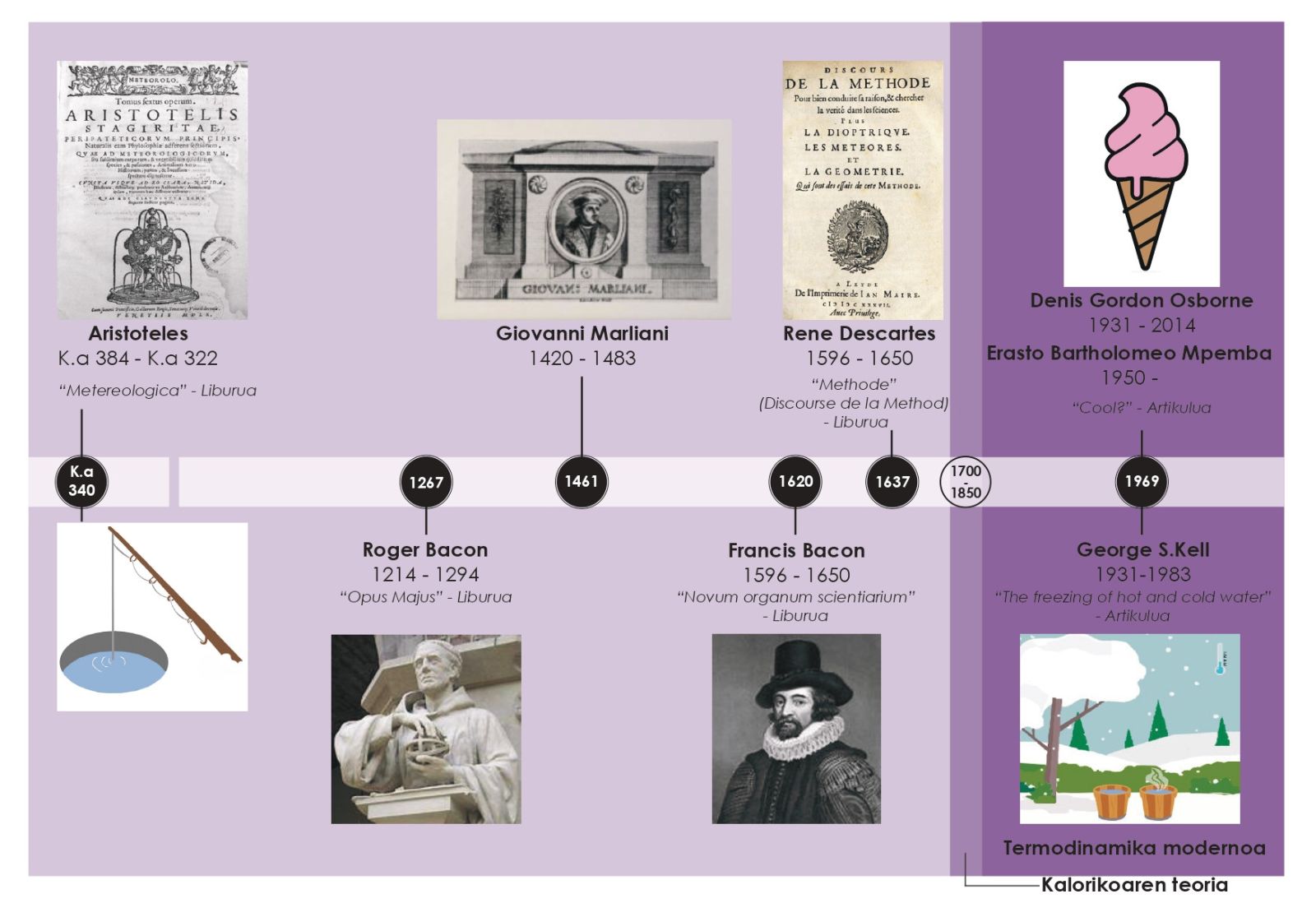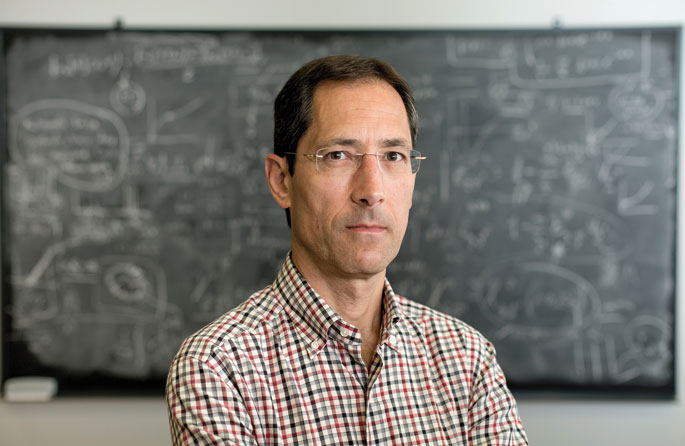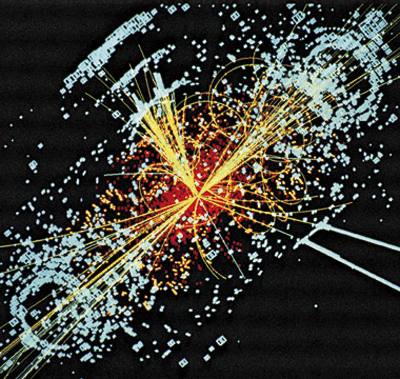An ice cream against Thermodynamics
- Who doesn't like ice cream? At least most boys and girls in the Basque Country do. In Tanzania this is also the case, more so given the usual temperatures. Thus, what was observed in 1963 by a child from Tanzania in the elaboration of ice cream is still very important. Sometimes, hot water freezes before cold water. In this article we discuss the history, characteristics and explanatory attempts of this strange effect.

In 1963, high school students in Magamba, in the Tanzanian Tank region, made ice cream. To do so, they mixed and cooked milk with sugar. Once the mixture was cooled at room temperature, it was introduced into the freezer section. However, due to the scarcity of space in the school freezer, one student introduced the mixture with presses without waxing it. Then another student, Erasto B. Mpemba introduced the cooked mixture but did not let it cool so as not to run out of place. An hour and a half later, Erasto's was frozen, and the other not yet! How is that possible? It goes against Intuition and Thermodynamics!
Even though his teachers and his environment did not give him importance, Mpemba wanted to give an explanation of what happened. Years later he met Denis Gordon Osborne, a professor at Dar es Salaam University at Mkwawa High School. Later, Mpemba and Osborne collaborated in an article published in 1969 in which they tried to explain what happened to ice cream through water. Since then, this curious phenomenon is known as the Mpemba effect.
And what before?
After Erasto's observation, interest in the strange thermal effects in the scientific community rose again. In fact, phenomena such as the Mpemba effect have been observed and collected throughout history. See the chronological axis of the following figure:

Aristotle apparently made the first reference to the Mpemba effect. a.C. By the year 350, he wrote in his book Meteorology that preheating water meant rapid freezing. So he said that in order for the water to cool quickly, it was convenient to put it in the sun. For example, when they were fishing in ice in the Ponto region, they would pour hot water around the rods to fast-fix.
In the 13th century, before the scientific revolution, Roger Bacon highlighted the importance of experiments for the proper development of science. It is also of the opinion that, under certain conditions, hot water can be frozen faster than cold water.
At the end of the Middle Ages, in 1461, Giovanni Marliani also observed the Mpemba effect. Then, in the 17th century, we can find two other testimonies. On the one hand, in 1620, Francis Bacon published his work Novum organum scientiarium, where he talked about its effect. On the other hand, in 1637, René Descartes published Les Meteores (as an annex to the famous Discourse of the Method), referring to the curious phenomenon.
In the 18th century, caloric theory was developed. Although it was discarded in the middle of the 19th century, we can still find on a daily basis traces of caloric. After the approval of the current theories of heat transfer, the observations of the Mpemba effect were rejected because they were contradictory.
Interestingly, the Mpemba effect has long been known outside academic environments. For example, in the Canadian folklore "it is known" that a cold day, if hot and cold water is put in two wooden containers, the hot water freezes faster. The Mpemba effect is not observable if covered in these wooden containers, or if the containers are metallic. In 1969 George S. Kell reported these facts in an article. But other events are also known on the street: for example, in frost hot water pipes explode more easily than cold water pipes. To cite another spectacular example, below zero temperatures snowflakes are formed when throwing boiling water, as shown in the following figure:

Definition
But what exactly is the Mpemba effect? In fact, there is no universally accepted definition. For example, consider two fragments of the same fluid with the same mass, where the only difference is the initial temperature of the liquid. Under the same conditions (in the same container and under the same zero mean), if the warm liquid freezes before the cold, the Mpemba effect is said to have occurred. It is sometimes required that only the liquid reach the freezing point, but it is also considered necessary that the freezing process occurs in the strictest definition, as shown in the following figure:

Trying to understand the causes
The simple explanation of the Mpemba effect through the laws of thermodynamics is impossible. In fact, the processes of cooling and freezing water are especially complex. Moreover, the Mpemba effect does not comply with Newton's cooling law. In fact, the energy lost by a body is proportional to the temperature difference of the body and its environment. According to this, the Mpemba effect would be impossible.
In recent decades, scientists have published different theories to explain the Mpemba effect. For example, in 2012, the UK Real Society of Chemistry hosted a competition to solve this strange phenomenon. It appears that the Mpemba effect is produced by the combination of several physical phenomena. The following are some of them:
• Evaporation. When a liquid evaporates, two important phenomena occur. On the one hand, the fluid loses mass. This may facilitate the Mpemba effect on small mass systems. On the other hand, it is necessary to absorb energy from the liquid for evaporation (endothermic process) to occur, which increases the decrease in the temperature of the liquid. However, evaporation is important only at high temperatures.
• Dissolved gases. In cold fluids, more gas dissolves than in warm fluids. That is, when the liquid is boiled, the dissolved gases are reduced. For example, the amount of oxygen dissolved in water at 0°C is 15 mg/l and at 100°C 3 mg/l. Thus, the properties of the liquid vary depending on the amount of dissolved gas. For example, a liquid with less gas can transmit more energy, cooling earlier. This would facilitate the Mpemba effect.
• Convection. Convection currents facilitate the release of energy from the liquid. The higher the convection, the faster the fluid cools down. Convection is also important at high temperatures.
• Supercooling. Water in liquid state at temperatures below 0°C is called supercooling. In the process of freezing hot water, for example, water can be kept in liquid state for a few degrees below zero. In the case of cold water, however, the temperature range up to freezing is higher. This makes it difficult to freeze cold water.
In the studies of recent years one can highlight a work. In 2016 Henry C. Burridge and Paul F. Lind scientists conducted a thorough investigation into the Mpemba effect. On the one hand, they took and compared the most important research so far, but concluded that there was a lack of information to repeat the previous experiments. On the other hand, they also performed experiments with water, but did not observe the Mpemba effect. In 2020, Burridge himself, with the help of a student, stated that he observed the Mpemba phenomenon. However, the starting point of the hot water was not the same as the cold water, as with the sandpaper they generated nucleation points on the vessel walls (increased roughness) to facilitate freezing. That is, the initial conditions of both water masses were not the same.
On the other hand, in 2017 other researchers theoretically analyzed the concrete conditions for observing the effect of Mpemba on granular fluids. This has its importance, as the effect will not always look. For example, if the initial temperatures are 99.9 °C and 0.01 °C, the Mpemba effect is difficult to produce. In this sense, they also affirmed the existence of the inverse of the Mpemba effect. That is, the initially colder system warms up before the one that is initially warmer.
The Mpemba effect is still not fully explained
In summary, the latest experiments suggest that the Mpemba effect is not produced with water. However, the Mpemba effect is real and, as already mentioned, it is also manifested in phenomena external to laboratories. Until 1969, scientists did not worry about the origin of these facts or the development of a formal explanatory theory. However, numerous investigations have been carried out in recent decades, but unfortunately the Mpemba effect still does not appear completely. It seems to have been observed in special systems such as granular secretions, carbon resonator nano tubes and gas hydrates. However, although the Mpemba effect is interesting, it is only a curiosity. In fact, it is not fundamental for the understanding of the basic concepts of Thermodynamics. The Mpemba effect reminds us of the importance of observation, fundamental for the continuous development of Science.
Grabitazio uhinen aurkikuntzak aro berri bat irekiko du gure unibertsoaren ezagutzan. Izan ere, grabitazio uhinei esker unibertsoaren iraganeko bilakaera ezagutu ahalko dute ikerlariek.
On 11 March, four years will come after the explosion of the Fukushima nuclear power plant in Japan. Researchers agree that this is the most polluting nuclear accident in history, but they do not agree on the consequences it will have. Assessing the consequences so far is... [+]
1964. urtean Higgs bosoien teoria plazaratu zen: unibertsoko partikula guztiek masa zergatik zuten azaldu nahi zuen. Sen onari erantzuten zion eta beste edozein teoriak baino probabilitate haundiagoak zituen egia izateko, baino 2012rarte ez zen frogatzerik izan.
Zientzia eta guda gizonezkoen alor esklusiboak ziren XX. mendearen hasieran. Espresuki debekatuak zitzaizkien emakumezkoei, neskametzarako edo gizasemeen menpeko lan anonimoetarako ez bazen behintzat.
Stephen Hawking fisikariak boikot akademikoa egingo dio Israeli, bertako presidente Shimon Peresen omenez egingo den ospakizunera joateko gonbidapena ukatuz. Gutun baten bidez eman du erabakiaren berri, Israelek palestinarrei emandako tratua gaitzetsi asmoz, The Guardianek... [+]
Last year, CERN announced that it had located neutrinos that moved at a faster rate than light, but it was subsequently shown that the origin of the alleged finding was nothing more than a poorly made measurement. After that failure, there comes the finding of the particle that... [+]
CERN laborategiko zientzialariek Higgsen bosoia izan daitekeen partikula aurkitu dutela iragarri dute gaur goizean. 1960ko hamarkadan Peter Higgs fisikari britainiarrak esan zuen partikula elementalen artean beste guztien jatorria izango zen partikula bat existitu behar zela,... [+]
Azken hamarkada bitan, materia atomoz atomo eta molekulaz molekula manipulatzeko gaitasuna garatu dugu gizakiok. Hartara, gauzatu egin da 1950eko hamarkadan Richard Feynman fisikari ospetsuak irudikatutakoa, berak izen hori eman ez bazion ere: nanoteknologia. Aukera berrien... [+]






















